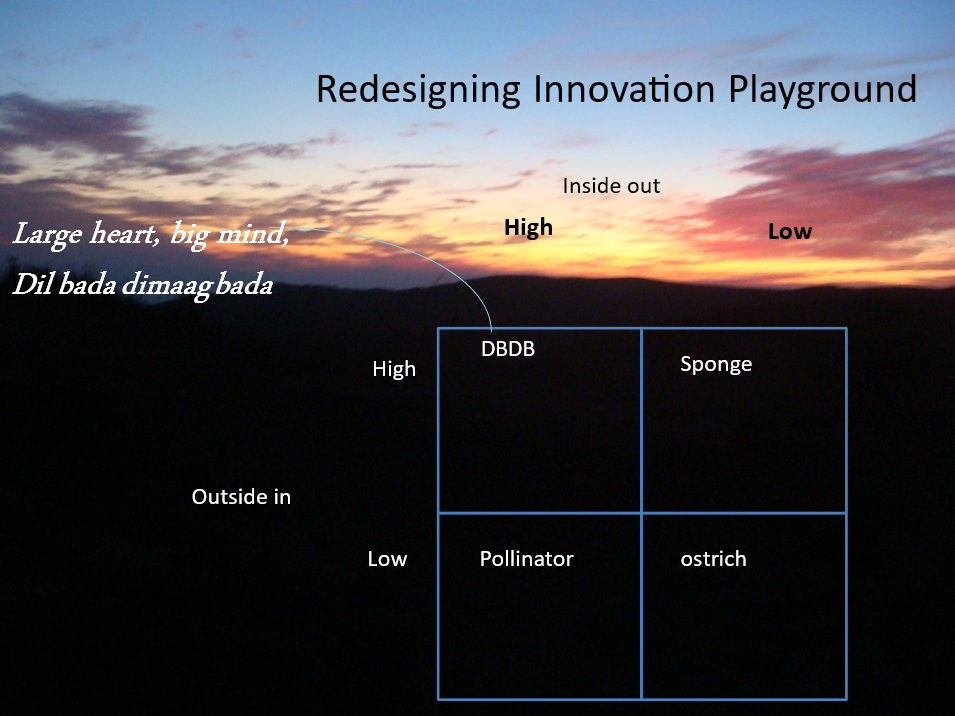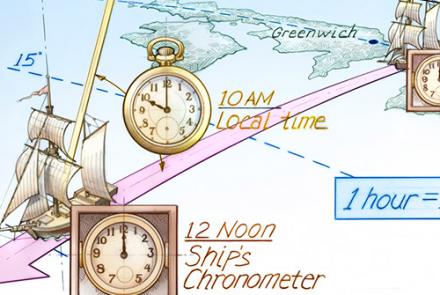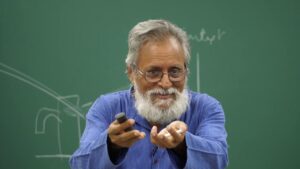The innovation playground can be redesigned by blending it with several other tools that bring in the creativity and innovation of all the actors in the supply chain, within and outside the organisation.
In Figure 1 of the matrix, there are 2 dimensions which are important drivers of innovation. The first is ‘inside out’, and the second is ‘outside in’.
‘Inside out’ implies the willingness of a company or an organization to share their own innovations with competitors, consumers, and other actors in society. ‘Outside in’ implies the willingness of the organization or company to learn from others as openly or eagerly as possible.
Both sides can have high or low-intensity efforts.

- Low Inside Out, Low Outside In: Organizations in this quadrant may be hesitant to learn from external sources and reluctant to share their own ideas. They operate within their constraints, much like an ostrich with its head in the sand. While this approach might feel safe, it can limit growth and innovation. Such organizations disappear in due course. It is unfortunate that
- High Outside In, Low Inside Out: These organizations are like sponges, absorbing knowledge and ideas from external sources but not actively contributing their insights. Crowdsourcing is a common strategy here, where companies/organizations seek ideas from outside contributors.
However, they often fail to share the information about the value they gain from these solutions with the idea providers. They pay a preassigned value in most cases to the solution provider. If they get a hundred or thousand times more value from that solution inside the company, letting the external innovator know will boost her confidence. They need not share any more monetary value with the solution provider.
Most crowd-sourcing organisations don’t give any feedback about the quality and impact of the solution. If done, it could boost the self-respect and confidence of the knowledge providers, Many multinational companies improved their profitability, patent workability and success rate of new product introductions. Among the solutions that the company did not use or did not intend to use, could not these be put in the public domain or one rupee licensing fee?
Raising innovation germination or sprouting quotient: In addition, the solution providers who make a very significant contribution could be acknowledged on the label of the product to highlight the value of responding to challenge awards or crowdsourcing campaigns for ideas. The social aspirations and appreciation for bottom-up solutions may also go up. Mor people may dare to share their ideas. It may increase the rate of innovation germination sprouting.
- High Inside Out, Low Outside In: This quadrant represents organizations that willingly share their knowledge and ideas but may not actively seek external input. They’re ahead of the curve and confident in their internal capabilities. Tesla’s approach to battery technology and charging stations exemplifies this—focusing on expanding the market for electric cars beyond their own brand.
Balancing internal and external perspectives is crucial for organizational success. Learning from others while contributing your own insights can lead to innovation and growth
- High Outside In and High Inside Out (DBDB – Dil Bada, Dimag Bada): In this quadrant, organizations have both a big heart (willingness to share) and a big mind (eagerness to learn). They confidently share their innovations as public goods besides for commercial purposes also and actively seek insights from outsiders. They follow an open inclusive innovation culture like startups and have a very high hunger for learning and willingness to share.
Balancing these strategies is essential for sustained innovation and growth. Organizations that combine openness to external ideas with confident sharing of their own innovations can thrive in today’s dynamic landscape.
Indeed, the combination of open, inclusive strategies within an innovation portfolio can significantly impact our ability to solve long-standing problems. Let’s explore this further:
- Mega Awards for Unsolved Problems:
- Way back in 1714, the British government offered a prize of £20,000 to anyone who could develop a device for determining a ship’s longitude accurately while at sea. The longitude prize ultimately led to significant advancements in marine navigation, with John Harrison, a watchmaker, eventually winning it in 1765 for his invention of the marine chronometer after several failed attempts at designing a solution.
- Recently, during COVID-19, The Mask Innovation Challenge was announced in 2021 by National Institute for Occupational Safety and Health (NIOSH) and Biomedical Advanced Research and Development Authority (BARDA) with winners getting up to 500k USD award for redesigning a comfortable mask to overcome the problem of fogging of glasses, irritation to skin and other inconveniences in communication.
- Why have we hesitated in announcing mega prizes for addressing unsolved social problems when existing processes or policies are not working well enough?
- Gandhiji’s Innovative Approach:
- Mahatma Gandhi demonstrated an innovative approach to problem-solving. From 1920 to 1928, he tried small In 1929, he announced a challenge award of £7,700 (equivalent to over ₹10 crore today) for a new design of the spinning wheel (charkha).
- The winning design had to meet specific criteria: it should be lighter, low-cost, and easy to maintain. The award encouraged grassroots innovators to participate and democratise solutions.
- Gandhiji’s awareness of open-source solutions allowed the innovator to retain the patent while making the design open-source.
- Unsolved Challenges Today:
- We face persistent problems, such as sanitation issues and water quality. Despite significant investments, some challenges remain unsolved.
- Consider the decline in public water supply quality over the past 20 years. While we once drank tap water without hesitation, many now prefer home filters. Should it not bother us? What about drinking water quality for the poor?
- The railways had announced a challenge award of just Rs 5 lakh to solve the problem of different platforms having different heights and thus causing discomfort to passengers. There are many other challenges which can be announced at district, state and national levels to harness the power of crowd/mass sourcing.
- Mega awards for solving wicked problems could incentivize innovators—whether in government or the private sector—to find solutions to various challenges.
- The Blended Innovation Playground:
- Let’s embrace a blended approach to redesigning the innovation playground. By combining open innovation, inclusive development, challenge awards, innovation public goods etc., we can enrich our repertoire and ignite imagination at all levels.
Remember, innovation knows no boundaries, every creative contribution matters, even from untrained minds, unchartered territories and remote margins of our society.
Prof. Anil Gupta, Founder, Honey Bee Network, SRISTI, GIAN, National Innovation Foundation, Visiting Faculty IIMA, IITB & CSIR












